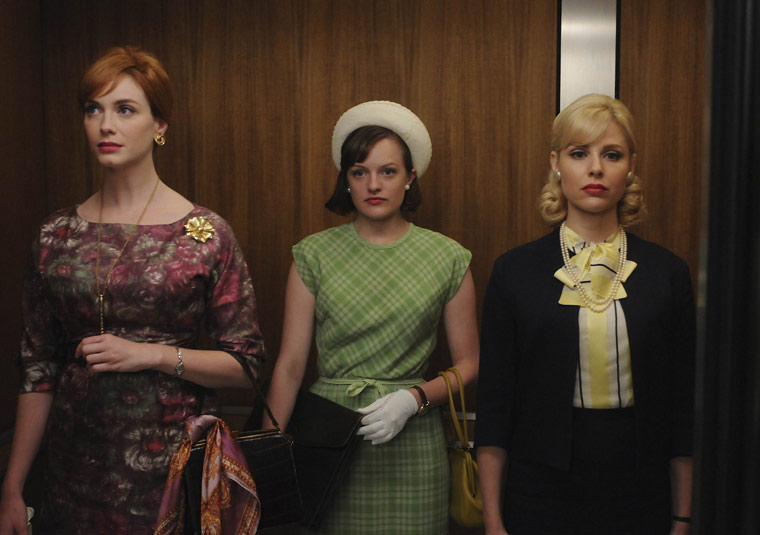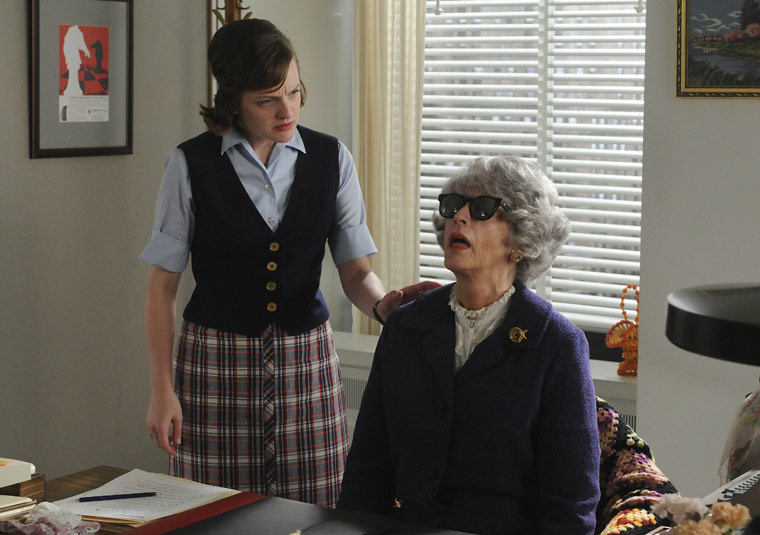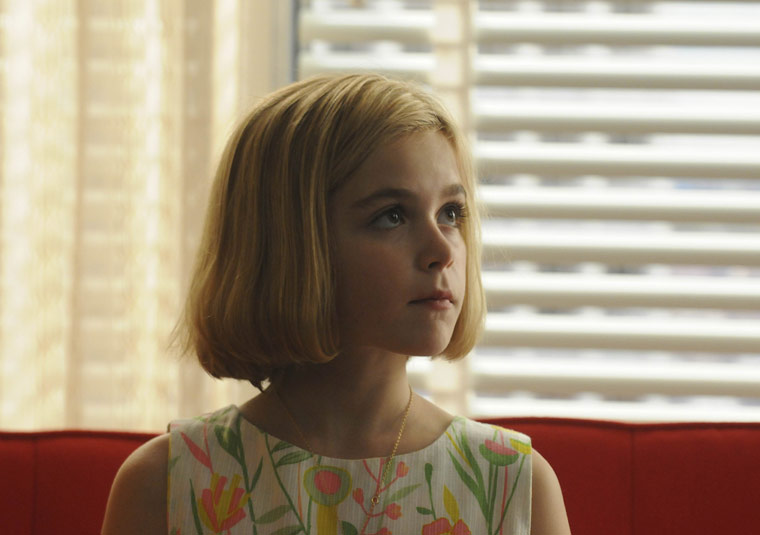With its depiction of a male-dominated world and characters who toss around sexist remarks without hesitation, it’s often been difficult to separate the views towards women of Mad Men the TV show from those of the characters who populate it. It’s difficult to call a show that features main characters like Don Draper and Roger Sterling as an example of feminist art, but the show’s writers have gone out of their way to show the hardships endured by women during this era (mostly in the form of Peggy), while still making sure the woman on the show are fully rounded characters, and not just symbols of their sex.
 This week the show focused on the multiple women in the Mad Men universe, and the way in which they’ve each chosen to navigate through this uncertain era. Peggy, Joan, Sally Draper, Dr. Faye, and even Mrs. Blankenship (may she rest in peace) all get extended screen time, and we see how the choices they’ve made and the eras they come from have influenced their lives.
This week the show focused on the multiple women in the Mad Men universe, and the way in which they’ve each chosen to navigate through this uncertain era. Peggy, Joan, Sally Draper, Dr. Faye, and even Mrs. Blankenship (may she rest in peace) all get extended screen time, and we see how the choices they’ve made and the eras they come from have influenced their lives.
Since she comprised the most memorable part of the episode, lets start with Mrs. Blankenship, who dies at her desk about halfway through. While she’s been used for mostly comic relief this season, she is clearly intelligent (we see her correct Burt Cooper’s crossword), and she also seems very aware with her place. Of Dr. Faye, she comments how “she’s pushy, that one. But I guess that’s what it takes.” During her youth, Blankenship could not have gotten away with that type of pushiness, and she’s now put off by this new generation that can get away with it. But for her time she probably went as far as she could go. Cooper rather beautifully describes her as an astronaut, saying how she was born in a barn in the 19th century and died on the 37th floor of a skyscraper. Roger is a little more (hilariously) cynical in his summing up of her life, saying “she died the way she lived, surrounded by the people she answered phones for.” I’ve been uncertain all season as to just why Mrs. Blankenship was on the show, but now it seems she was there to show us the previous generation moving out, giving way to new women like Peggy and Faye.
Also, she was there to give us one of the funniest sequences in Mad Men history, when they attempt to wheel her corpse out of the office undetected, all while Don attempts to keep a straight face to this going on literally behind his client’s back. Peggy, for her part, has attempted to have it multiple ways. She wants to be a part of this new generation, and has used the freedoms it has granted her to get a job she could never have had a few years earlier. At the same time, she wants to be a part of Sterling Cooper, and will play along with its old-fashioned views for the sake of her work. Here those two things come into direct conflict when she goes on a date (with the man she made out with a few episodes ago during the raid on an art show). He doesn’t understand how she can represent a client (Fillmore Auto) who refuses to hire black workers. Peggy is not unsympathetic to this injustice, as she does bring it up to Don during a meeting, but she also is willing to do her job in spite of it. What she refuses to do is listen to her date belittle her struggles as a woman, when she attempts to compare women’s suffrage to civil rights. Not too long ago Peggy might have been willing to put up with this man’s condescension (she put up with worse when she was seeing Pete in season one), but now she’s confident enough in her beliefs and her life choices to know that this man is not what she wants.
Peggy, for her part, has attempted to have it multiple ways. She wants to be a part of this new generation, and has used the freedoms it has granted her to get a job she could never have had a few years earlier. At the same time, she wants to be a part of Sterling Cooper, and will play along with its old-fashioned views for the sake of her work. Here those two things come into direct conflict when she goes on a date (with the man she made out with a few episodes ago during the raid on an art show). He doesn’t understand how she can represent a client (Fillmore Auto) who refuses to hire black workers. Peggy is not unsympathetic to this injustice, as she does bring it up to Don during a meeting, but she also is willing to do her job in spite of it. What she refuses to do is listen to her date belittle her struggles as a woman, when she attempts to compare women’s suffrage to civil rights. Not too long ago Peggy might have been willing to put up with this man’s condescension (she put up with worse when she was seeing Pete in season one), but now she’s confident enough in her beliefs and her life choices to know that this man is not what she wants.
Joan, as opposed to Peggy, has embraced the views of Mrs. Blankenship’s generation and taken it as far as she could. Starting out as a secretary and using her sexuality as much as she could, she’s gone extremely far. She has a good job as the office manager, and an extremely handsome husband. But these choices have also put her in a position where most of the men in the office don’t respect her, she has no female friends, and her husband is an insecure ass who joined the army without telling her. Additionally, she works with someone, Roger, who she has true feelings for but can’t act on them. Unless of course they’re walking down the street together and they’re mugged, because the heightened emotions of that scene will lead to them passionately having sex in an alleyway. While the “near-death-experience-leading-to-sex” scene is a bit clichéd for Mad Men, I was just happy to see Joan and Roger back together. While it might not happen again (Joan admits that she doesn’t regret it but that she is still married), it did cause Joan to admit that she may want things she doesn’t currently have in her life, and it may not be impossible for her to go out and get them. Sally Draper, on the other hand, is far too young to go out and get these things she knows she wants. Living with a mother who openly hates her, Sally dreams of living with her father, whom she rarely sees. This leads her to run away and end up at Don’s office unexpectedly. Unfortunately for her, Don isn’t any more capable of caring a child than his ex-wife is, even if he understands how mean Betty is to her. Due to her age, Don has always refused to see Sally as an actual person, such as when he refused to discuss death with her when she was clearly traumatized by Grandpa Gene’s death. Here he refuses to give her an actual answer when she wants to know why she can’t live with him. Although he is impressed by how observant Sally is when she figures out that Don and Faye are together by the fact that Faye knows that Don has peanut butter. In the end, she gets to have a great day at the zoo with her dad, but is unable to make any real change and is sent home with Betty.
Sally Draper, on the other hand, is far too young to go out and get these things she knows she wants. Living with a mother who openly hates her, Sally dreams of living with her father, whom she rarely sees. This leads her to run away and end up at Don’s office unexpectedly. Unfortunately for her, Don isn’t any more capable of caring a child than his ex-wife is, even if he understands how mean Betty is to her. Due to her age, Don has always refused to see Sally as an actual person, such as when he refused to discuss death with her when she was clearly traumatized by Grandpa Gene’s death. Here he refuses to give her an actual answer when she wants to know why she can’t live with him. Although he is impressed by how observant Sally is when she figures out that Don and Faye are together by the fact that Faye knows that Don has peanut butter. In the end, she gets to have a great day at the zoo with her dad, but is unable to make any real change and is sent home with Betty.
It’s rare that an episode would spend such a short amount of time focusing on Don, but Mad Men isn’t a show short on interesting characters. Even in an episode such as this, where the main character plays a supporting role, there are still central characters who barely make appearances (I’m looking at Pete, who has a cameo wheeling away Blankenship’s corpse, but other than that is MIA for the second week in a row). But Mad Men isn’t simply the story of Don Draper. It’s the story of a time in our history, and the changes that came with it. Changes that not everyone was ready for, and not everyone went along with. People had to make their own choice as to whether they were going to accept these changes or were going to die away.